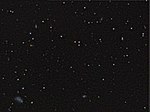Luhman 16 (also designated WISE 1049−5319 or WISE J104915.57−531906.1) is a binary brown-dwarf system in the southern constellation Vela at a distance...
43 KB (4,286 words) - 05:45, 9 August 2024
Luhman is a professor of astronomy and astrophysics from Pennsylvania State University who discovered both the third-closest stellar system, Luhman 16...
3 KB (298 words) - 23:04, 10 December 2023
are located in the Luhman 16 system, a binary of L- and T-type brown dwarfs about 6.5 light-years (2.0 parsecs) from the Sun. Luhman 16 is the third closest...
186 KB (20,207 words) - 20:59, 12 August 2024
system (including Proxima Centauri), Barnard's Star, and the brown dwarfs Luhman 16 (WISE 1049-5319) and WISE 0855−0714 known to be closer. Its proximity...
41 KB (4,043 words) - 11:04, 14 August 2024
Alpha Centauri system, Barnard's Star, Wolf 359, and the brown dwarfs Luhman 16 and WISE 0855−0714 are known to be closer. Because of its proximity it...
32 KB (3,049 words) - 16:20, 13 August 2024
800..134M. doi:10.1088/0004-637X/800/2/134. ISSN 1538-4357. S2CID 555496. Luhman, K. L.; Patten, B. M.; Marengo, M.; Schuster, M. T.; Hora, J. L.; Ellis...
146 KB (13,052 words) - 16:32, 9 August 2024
Earth trojan asteroid, 2010 TK7. Also, the third-closest star system, Luhman 16. As of May 2018, WISE / NEOWISE had also discovered 290 near-Earth objects...
76 KB (7,564 words) - 19:29, 11 August 2024
Earth, respectively. The discovery of a binary brown dwarf system named Luhman 16 only 6.6 light-years away, the third-closest system to the Solar System...
22 KB (2,552 words) - 00:43, 23 April 2024
to the Sun, the discovery of which was announced in April 2014 by Kevin Luhman using data from the Wide-field Infrared Survey Explorer (WISE). As of 2014[update]...
20 KB (1,793 words) - 23:57, 19 July 2024
of 5.936±0.016 mas. The projected rotational velocity is a relatively low 16 km/s, which does not produce any significant flattening of its disk. This...
96 KB (10,119 words) - 04:45, 10 August 2024








